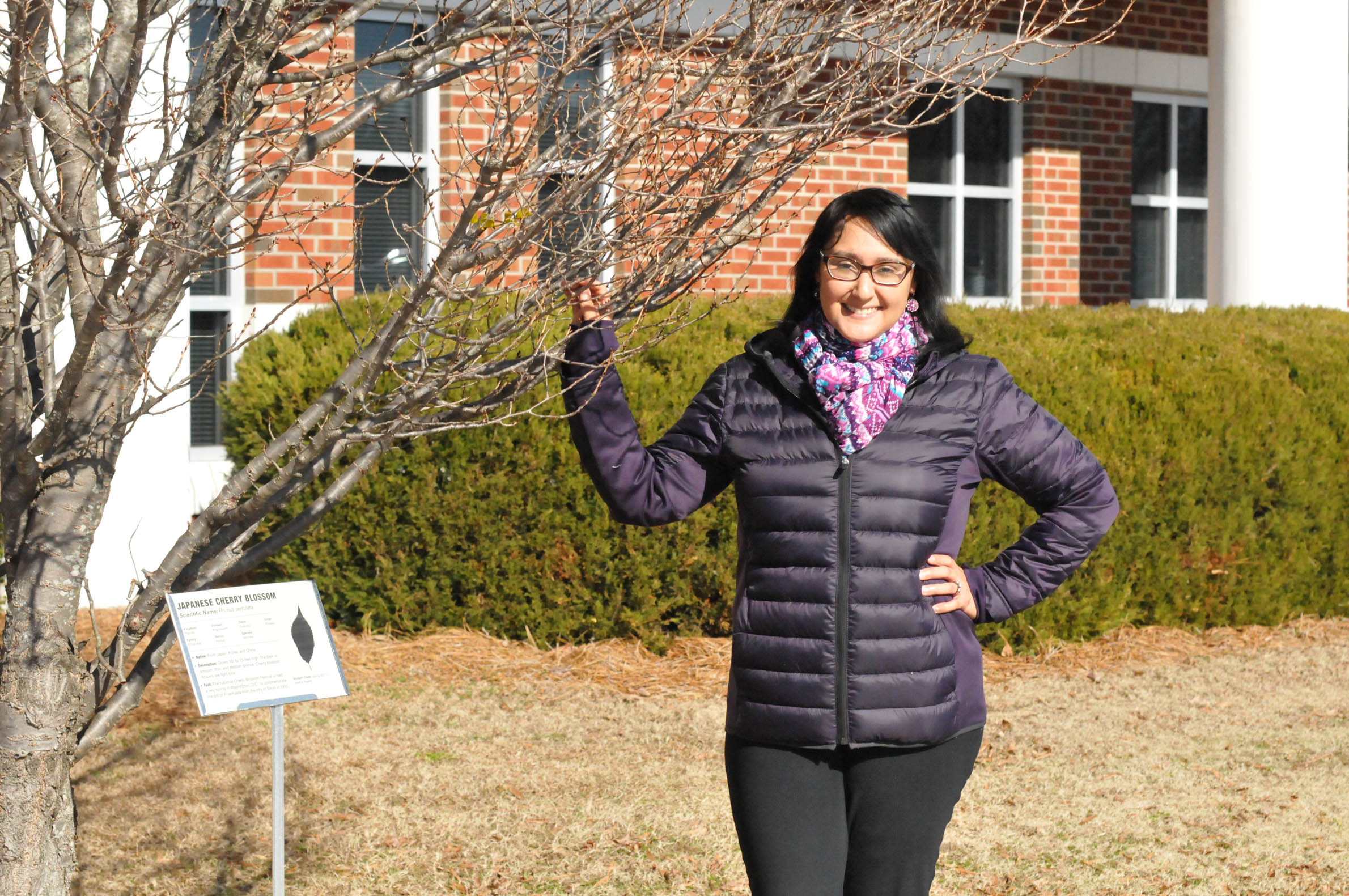
Central Carolina Community College Biology Instructor Anthea Saez stands beside one of the trees selected for the "Tree Identification Project" on the CCCC Lee Main Campus in Sanford.

SANFORD - You can see it now, a recent addition by students to the Central Carolina Community College Lee Main Campus, but when spring arrives in just a few weeks, it will become even more glorious. For young scholars who created the humbly named "Tree Identification Project," it was a class assignment turned labor of love. For anyone who wanders through campus and takes time to stop and enjoy, it's insight into our rich natural environment.
The idea was fairly simple. Wanting to make what students were learning even more tangible, CCCC Biology Instructor Anthea Saez asked her classes to identify plants around the campus, learn about them and then develop small signs to help anyone walking by appreciate what they're seeing.
One of those signs now stands just off the sidewalk bordering a busy parking lot, steps from the Science Building. It reads:
Japanese Cherry Blossom
Scientific Name: Prunus serrulata
Native: From Japan, Korea, and China.
Description: Grows 50' to 75-feet high. The bark is smooth, thin, and reddish-bronze. Cherry blossom flowers are light pink.
Fact: The National Cherry Blossom Festival is held every spring in Washington, D.C., to commemorate the gift of P. serrulata from the city of Tokyo in 1912.
There are nine others so far. More could be made, Saez says, but an initial grant from the CCCC Foundation covered the cost for 10 signs. Some of them stand in other high-traffic areas, others slightly more obscure locations, but each includes a silhouette of the leaf, a full classification of the tree and a credit for the student researcher.
The project may seem simple, but it wasn't easy. It took almost a year, start to finish, with a couple of unexpected detours, some seasonal delays and plenty of work outside of class. It enlisted two semesters of biology students who selected the trees and conducted the research. Laser and Photonics students who helped fabricate the signs. Several college departments assisted with the implementation of the project.
Saez says the idea came from similar projects she worked on as a graduate student at N.C. State and researcher in Costa Rica. But when she sprung the idea on her biology students, the reaction was mixed. "There was a little fear about how much work they'd have to do, but they were excited that they'd be doing something different. Being in the lab all semester, people can get bored with it," the instructor said.
Another educational advantage: This project required collaboration.
Joel Benitez thought it was going to be pretty easy when he first heard about the project as a student in General Biology II, especially since he had the entire semester to compete the work. But, he says, the project was a lot more time-consuming than he thought.
Their full assignment was to locate trees from 10 different tree classifications. So, his group of four went on a botanical safari, taking photos of trees that might fit the bill, doing research to make sure what they found was actually the tree they thought. When it wasn't, they ventured back into the wild. Once the trees were selected and verified, they compiled their research into a paper and presentation. Signs on campus were later adapted from those presentation slides.
"That was a lot," Benitez says, looking back. "That was my reaction. I couldn't believe we did this all together."
Visitors taking the time to stop and read now have a different perspective of the college campus. Students participating in the Tree Identification Project also have a different perspective -- of their natural world.
Benitez says he was impressed by the biological diversity, especially in a fairly confined area. Annual and perennial. Native species and those, like the Japanese Cherry Blossom, that have been introduced from half a world away. Even a few that were created by experimental engineering. He talks about how it's important to preserve natural resources we have, to protect species from going extinct.
Oh, and there was one other insight Benitez gleaned from weeks of painstaking field research: "There are a lot of pine trees."
For information about Central Carolina Community College and its programs, visit its website, www.cccc.edu or call the college at 919-775-5401.

Central Carolina Community College Biology Instructor Anthea Saez stands beside one of the trees selected for the "Tree Identification Project" on the CCCC Lee Main Campus in Sanford.